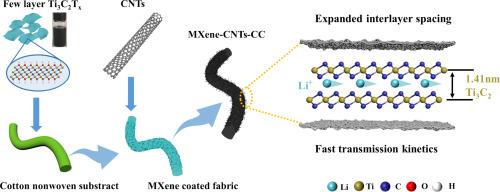灵活、独立的 MXene 装饰生物质衍生碳布膜阳极,用于制造卓越的锂离子电容器
IF 8.9
2区 工程技术
Q1 ENERGY & FUELS
引用次数: 0
摘要
二维过渡金属材料(MXenes)因其层状结构、良好的导电性和丰富的官能团而在储能应用中备受关注。在这项研究中,Ti3C2Tx MXene 纳米片和碳纳米管(CNTs)被均匀喷涂,并通过静电自组装成功负载在棉质无纺布衍生的碳布(CC)基底上。制备的柔性 MXene-CNTs-CC 膜电极具有更大的层间距和高导电性织物支撑,表现出优异的电化学性能。在锂离子电池方面,优化的 MXene-CNTs-CC 阳极在 0.1 A g-1 的条件下可提供 2277.5 mAh g-1 的超高初始放电容量,同时在半电池中具有显著的循环能力(100 次循环后为 1149.8 mAh g-1)和速率能力(2 A g-1 条件下 200 次循环后为 544.1 mAh g-1)。使用钴酸锂阴极组装的全电池也显示出良好的循环稳定性,在 0.1 A g-1 条件下循环 100 次后,可逆放电容量高达 833.5 mAh g-1。值得注意的是,使用所设计的多孔碳纳米纤维阴极进一步构建的锂离子电容器可以保持 121.5 至 20.8 Wh kg-1 的能量密度,相应的功率密度为 125 至 12,500 W kg-1,并且在 1 A g-1 下循环 10,000 次后电容保持率达到 76.3%,显示了出色的长期循环耐久性。本文章由计算机程序翻译,如有差异,请以英文原文为准。

Flexible and free-standing MXene decorated biomass-derived carbon cloth membrane anodes for superior lithium-ion capacitors
Two-dimensional transition metal materials, MXenes, have attracted tremendous attention in energy storage applications due to their layered structure, good electrical conductivity, and abundant functional groups. In this work, Ti3C2Tx MXene nanosheets and carbon nanotubes (CNTs) were uniformly sprayed and successfully loaded on the cotton nonwoven fabric-derived carbon cloth (CC) substrate by electrostatic self-assembly. The as-prepared flexible MXene-CNTs-CC membrane electrodes with enlarged interlayer spacing and high conductivity fabric support exhibited excellent electrochemical performance. In terms of lithium-ion batteries, the optimized MXene-CNTs-CC anode delivered an ultrahigh initial discharge capacity of 2277.5 mAh g−1 at 0.1 A g−1 along with notable cyclability (1149.8 mAh g−1 after 100 cycles) and rate capability (544.1 mAh g−1 after 200 cycles at 2 A g−1) in half cells. The full cells assembled with LiCoO2 cathode also displayed good cycling stability with a high reversible discharge capacity of 833.5 mAh g−1 after 100 cycles at 0.1 A g−1. Remarkably, the further constructed lithium-ion capacitors with the designed porous carbon nanofiber cathode could maintain energy densities of 121.5 to 20.8 Wh kg−1 with the corresponding power densities of 125 to 12,500 W kg−1, and achieved capacitance retention of 76.3 % after 10,000 cycles at 1 A g−1, demonstrating excellent long-term cycle durability.
求助全文
通过发布文献求助,成功后即可免费获取论文全文。
去求助
来源期刊

Journal of energy storage
Energy-Renewable Energy, Sustainability and the Environment
CiteScore
11.80
自引率
24.50%
发文量
2262
审稿时长
69 days
期刊介绍:
Journal of energy storage focusses on all aspects of energy storage, in particular systems integration, electric grid integration, modelling and analysis, novel energy storage technologies, sizing and management strategies, business models for operation of storage systems and energy storage developments worldwide.
 求助内容:
求助内容: 应助结果提醒方式:
应助结果提醒方式:


